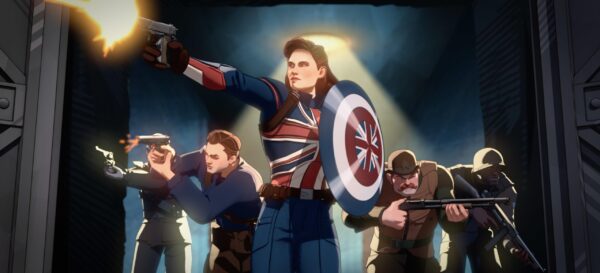
Marvel has often taken to the task of patience in his shows. It always said that Netflix programs had been padded, with more installments than they really needed per season. The era of Disney + has given us shows with fewer episodes, but that has not dissuaded complaints about slow rhythm. What happens if …?, It was released this week in the service, has a different problem: it is frantic and hurried, as an episode of podcast played at the speed of 1.5x.
The concept behind what happens if …? it is simple. Take a fundamental moment of Marvel’s cinematographic universe, change one thing, see what happens. In the episode of Premiere, established during the Events of Captain America: the first Avenger, Peggy Carter chooses to stay in the room where Steve is receiving the Super Soldier. Steve receives a shot, forcing Peggy to jump to the machine and be bulged in the place of her.
He will have to be intimately familiar with the original film to detect the difference, so the omniscient narrator is there to point out. It is probably the only time that the episode stops to recover the breath away from him.
The problem is that this is a half-hour program that tries to present an alternative version of a two-hour movie. It is not enough to say that Captain Carter has superpayer; They feel the need to show how the events of the entire film are reproduced, to the final battle with the red skull. There is not much time for the development of characters, because it assumes that you already know the characters well see them on the silver screen. (In addition, why is she Captain Carter and not captain Great Britain?)
You will have to be intimately familiar with the original movie to detect the difference, so the omniscient narrator is there to point out. It is probably the only time that the episode stops to recover the breath away from him.
The problem is that this is a half-hour program that tries to present an alternative version of a two-hour movie. It is not enough to say that Captain Carter has superpayer; They feel the need to show how the events of the entire film are reproduced, to the final battle with the red skull. There is not much time for the development of characters, because it assumes that you already know the characters well see them on the silver screen. (In addition, why is she Captain Carter and not captain Great Britain?)
But, despite being owned by one of the most famous animation studios in the world, Marvel Studios was with third-party animators. It is a shaded cel style, which is used more often in videogames and here it looks a lot like the Rotoscopes. It is a kind of rigidity and uncomfortable, with a greater attention so that the characters resemble their actors instead of being more fluid or expressive. It is a shame, given that Disney’s 2012 short film Paperman used a 2D / 3D hybrid style that looks like this, but with much more personality.
Future episodes will explore other divergences from the MCU, such as T’challa, became Star Lord or Tony Stark who feels saved by Killmonger. Therefore, it is likely that some episodes are much more pleasant than others depending on their concept, although Captain Carter remains a solid start. But a good concept can not completely overcome animation and stimulation issues.



